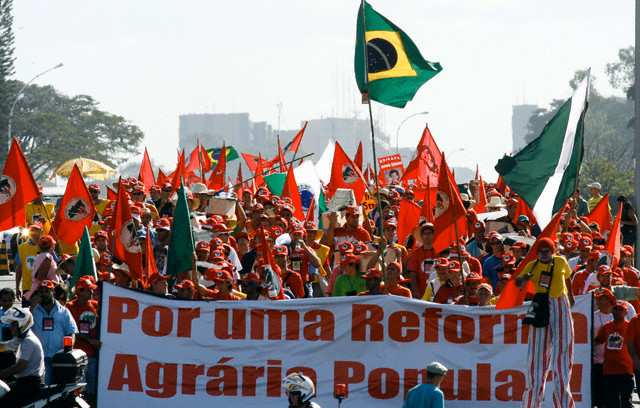By Lindley Mease
The CLIMA Fund supports groups that stop and prevent this devastation going forward.

The Amazon is burning, Indigenous Peoples are standing up for the forests that have supported life on the entire planet, and youth are taking to the streets globally to demand change. Activists in Brazil and around the world are putting their lives on the line for the Earth. Frontline communities are those who suffer the most negative impacts of the climate crisis and, despite the latest onslaught, they serve as sentinels and seers. How can the rest of us stand with them?
The most important thing we must do is shift our thinking about ‘scale’ when it comes to climate change. “This crisis is urgent – we must invest in the solutions that can drawdown the most emissions now”. I’ve always been skeptical of this framing. It presumes that policies can be implemented across cultures, political contexts, and ecosystems. The preoccupation with “scale”, when it is defined by the scope of technological strategies which are believed in theory to be applicable rapidly and widely, limits our imaginations.
Not only does the “scale” assumption need to be re-examined but it keeps us from focusing on strategies developed from the wisdom of local communities. These are “climate solutions” which are likely to last and will lead to collective well-being. How might we expand our understanding of scale to include solutions that advance systemic change that actually works for everyone?
I got my first taste of how movements create scaled change on the personal, community, and international level, when I met with movement leaders in Brazil. The Movement of Artisanal Fishermen and Fisherwomen is a national movement of fisherfolk protecting livelihoods and waterways in 19 out of 24 Brazilian states. The Landless Workers Movement has 1.5 million members across Brazil and now produces food sustainably on land area larger than the state of Massachusetts. The Movement of People Affected by Dams has a membership of 18,000 families resisting and preventing the expansion of mega-dams which threaten their lives and the country’s water resources, which also represent 12-16% of our global water supply. That’s scale.
These movements’ deep political formation and social mobilization represents remarkable organizational power for resisting the extractive industries threatening our collective well-being. Millions of local people, who have the best understanding of their local ecosystems, possess the vision and self-determination to fight for control and preservation of their homes in the face of mass climate displacement.
Over the last six months, the CLIMA Fund (made up of Global Greengrants Fund, Grassroots International, Thousand Currents, and Urgent Action Fund for Women’s Human Rights) gave $80,000 to movement groups in Brazil like those mentioned above. Grants supported local community groups training youth in agroecology methods, building community gardens, protecting Amazonian Indigenous cultural diversity, developing distributed community solar grids, conducting advocacy with government agencies, and learning exchanges for resisting large hydro-projects threatening community lives and lands.
We understand that it’s not about funding one strategy, or only the biggest organization. We have learned from activists that systemic change happens when many, interconnected organizations that are accountable to communities have the resources they need. This is why the CLIMA Fund reaches grassroots organizations advancing climate justice in 168 countries globally.
In addition to Brazil, we made grants to groups across our global network. We partnered with movement groups getting local Indigenous leaders elected to public office, where they can represent those with the greatest stake in the preservation of our collective biodiversity. We funded groups working locally to ensure food sovereignty on hurricane-ravaged islands or internationally to fight the industrial agricultural companies forcing dependence on non-native, genetically-modified seeds among farmers struggling on increasingly water scarce lands. We supported groups led by women securing their economic independence through their cultural inheritance.

For example, SAVE Rivers Sarawak in Malaysia supports riverkeepers’ resistance to energy development which threatens the forests and waterways they depend on for their survival. Asociación Ikiran in Perú tools up Indigenous youth in activist strategies using innovative art and video methods for resistance efforts in their territory. South Durban Community Environmental Alliance (SDCEA) in South Africa is creating a community plan for renewable energy, waste management, eco-tourism, and green infrastructure on their land, and training community leaders in solar installation and maintenance. Escuela El Sur Camina, a women and Indigenous-led group in Colombia, preserves the traditional knowledge of local Indigenous communities that seek to protect the largest remaining neotropical alpine tundra ecosystem in the world, and the main water source for Bogotá. Indigenous women delegates of WECAN engaged in advocacy at the 2019 United Nations Permanent Forum on Indigenous Issues. Indigenous women leaders of the tribe at Unist’o’en Camp defending their land from the Coastal Gaslink Pipeline with an injunction.
Yes, the Amazon is burning, but we can stand with people with intrepid, creative visions who know how to make the necessary changes to stop and prevent these catastrophes and devastation going forward. The recent report Soil to Sky: Climate Solutions That Work shows that grassroots movements around the world have the potential to drawdown carbon emissions more than conventional “climate solutions” can. What happens when you add up all of these different efforts? An interconnected, global climate movement acting commensurate with the scale of the climate crisis already exists.
So I ask again, how can the rest of us stand with them?
To learn more about grassroots climate solutions, visit www.climasolutions.org and attend our webinar on October 29th, 9am PST, where grassroots activists will share stories of their work.